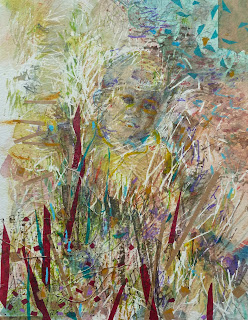David Hockney - The Bigger Picture
Well this was pretty interesting. Some good fortune came my way to allow me to see Hockney's Yorkshire vistas , and big they certainly were. This exhibition was exciting for an artist who is exploring her own local landscape. I loved the drama and enthusiasm for the dales which was evident everywhere.
 The arrival of spring, viewed from the first gallery is a an image created from 32 canvases. I was captured by the stylised motifs, the way colour is used to make images recede and advance, that complimentary colours are used to outline important elements. These techniques are used throughout the work.
The arrival of spring, viewed from the first gallery is a an image created from 32 canvases. I was captured by the stylised motifs, the way colour is used to make images recede and advance, that complimentary colours are used to outline important elements. These techniques are used throughout the work.
Hockney is a master of mark making - even with what might be considered fairly crude electronic tools. The colours are used with boldness and confidence. Think alizarin red, magenta, violet, burnt sienna, and naples yellow; creating the ploughed field in the Thirkendale Trees. These colours are laid on with bold strikes, splodges, and blobs that gently recede into the distance. Paint can be laid on thickly and then scaled back (or not) or can be applied thinly in washes allowing the canvas to show through, and this can all be in the same painting.
I loved the sensitive charcols and the idea of looking at the continuing 'life after death' of the trees. I thought this was his most successful work. Simpler forms and stylised colour with exciting mark making. These painting, evocative of a sinister Disney world, are surreal and absorbing. They are more intense and provocative, creating questions about mortality and our purpose and place in life.
After the exhibition I took a wander round the National Gallery, well some bits of! I was struck by Van Gogh's painting of his chair. This beautiful painting included some of the same techniques of Hockney, namely a lot of viridian, impasto paint to describe texture and outlining form with complementary colour. The scale is completely different, the subject matter -still wood! Utterly beautiful!





